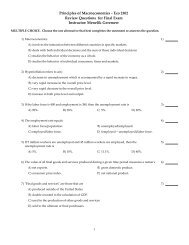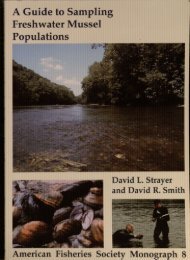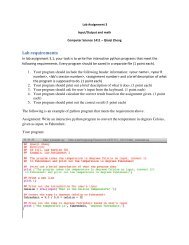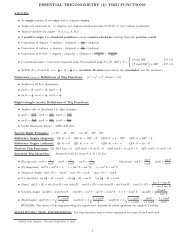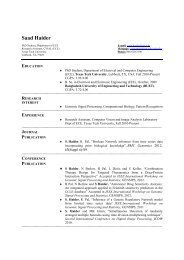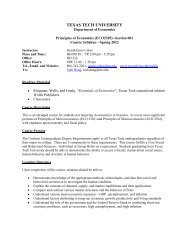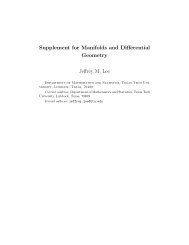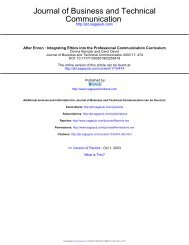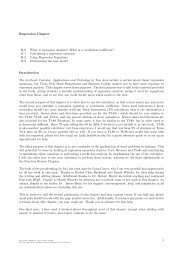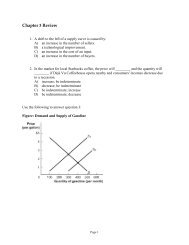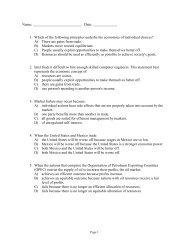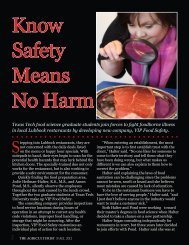Download - MyWeb - Texas Tech University
Download - MyWeb - Texas Tech University
Download - MyWeb - Texas Tech University
Create successful ePaper yourself
Turn your PDF publications into a flip-book with our unique Google optimized e-Paper software.
Archaeo-geophysical Survey of the Upper Plaza<br />
of good resolution at depths between 0.15 m<br />
and 1.5 m below the ground surface.<br />
Electrical Resistance<br />
Resistance surveys measure the resistance to<br />
the flow of electric currents through the ground<br />
(Gaffney and Gater 2003:26). Resistance<br />
surveys can record differences in soil<br />
compaction, moisture content, and locations of<br />
highly resistant features such as stone (as in stone<br />
walls or foundations). Resistance surveys are<br />
suited to the geological conditions of the desert<br />
and Great Plains as well as the well-defined<br />
archaeological targets such as pit houses and<br />
adobe structures that are found in those regions.<br />
Depending on local site and soil conditions,<br />
in North American prehistoric archaeological<br />
sites, most features recorded with resistance<br />
will be negative resistance features, meaning<br />
that they fall below the background resistivity<br />
of the site (Somers 2006:112). This is due to<br />
the fact that most prehistoric features in North<br />
American archaeological sites will take the<br />
form of some sort of negative relief feature<br />
composed mainly of, at varying degrees, soil<br />
disturbance.<br />
Resistivity surveys are controlled by constant<br />
variables including electric current, voltage,<br />
and the geometry of the resistivity probe<br />
array. The most common probe configuration<br />
is known as the Twin Probe Array, and it was<br />
developed specifically for archaeological<br />
purposes (Gaffney and Gater 2003:27–34;<br />
Somers 2006:112–115). This array uses a set<br />
of mobile probes, one injecting the current and<br />
one recording the reading (which is an average<br />
of the resistance in the area between the two<br />
probes), usually spaced with a 0.5 m separation.<br />
Probe spacing can be changed to resolve<br />
geophysical data to different depths. The 0.5 m<br />
separation has proven to be the most useful in<br />
electrical resistance for shallow archaeological<br />
deposits (Gaffney and Gater 2003:60). A set of<br />
probes are placed off the collection grid at a<br />
distance 30 times the mobile probe separation<br />
from any point on the grid (i.e., 15 m off the<br />
grid when using a 0.5 m separation). The<br />
GeoScan Research RM15 resistivity meter<br />
was used during the geophysical survey of the<br />
Upper Plaza.<br />
Conductivity and Magnetic Susceptibility<br />
(EM)<br />
Conductivity surveys measure the ability to<br />
conduct an electric current (Clay 2006:79).<br />
This measurement is the theoretical inverse to<br />
resistivity; however, measuring conductivity<br />
entails a much more complex set of procedures<br />
than does resistivity (Bevan 1983:51; Clay<br />
2006:79). The conductivity meter has a set of<br />
wire coils, one transmitting a low frequency<br />
signal and one receiving the signal. Rather<br />
than inserting probes into the ground, the<br />
conductivity meter is simply carried above the<br />
earth surface, and data are logged automatically.<br />
This makes conductivity surveys time and<br />
labor efficient.<br />
Conductivity meters can resolve data at<br />
different depths by changing the separation<br />
of the transmission and receiving coil and by<br />
transmitting its signal at different frequencies.<br />
Some instruments allow for these variables to be<br />
changed and others, like the Geonics EM38—<br />
the most widespread conductivity meter used in<br />
American archaeology, and the instrument used<br />
in this project—are not adjustable. The EM38B<br />
will measure conductivity to approximately 1.5<br />
m below the surface when set in the vertical<br />
dipole mode (Ernenwein 2008:133).<br />
Magnetic susceptibility is a measurement of<br />
a material’s ability to be magnetized (Dalan<br />
2006:161). Changes or contrasts in the magnetic<br />
susceptibility of sediments are the results of a<br />
conversion of weakly magnetic oxides and<br />
hydroxides to more strongly magnetic forms<br />
(Dalan 2006:162). Burning episodes (both<br />
9



